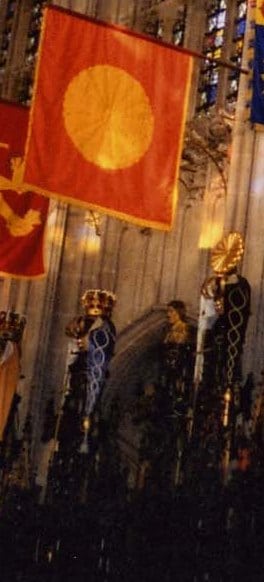Emperor Akihito and the heraldic achievements of the Garter
Banner of Akihito

Born in Tokyo on the 23rd December 1933, Akihito was the eldest son and fifth child of Emperor Hirohito of Japan. His official investiture as crown prince of Japan took place in 1952. After the death of Emperor Hirohito in 1989, he received the succession and in the same year he was appointed Grand Cordon and Collar of the Supreme Order of the Chrysanthemum. On 12 November 1990, he ascended the Chrysanthemum Throne in an elaborate ritual. Eight years later, in 1998, during a state visit to the United Kingdom he was invested in the Most Noble Order of the Garter, making him the 830th Knight of the Order. In terms of arms, the Emperor’s Garter banner is not strictly speaking heraldic as there is no heraldry as such in Japan. The banner has a red background and displays a gold chrysanthemum; this is the imperial seal of Japan and is also employed as the crest of the Emperor, carved from solid mahogany by sculptor Ian G Brennan, which can be seen over his stall in St George’s Chapel,.
The chrysanthemum banner representing Emperor Akihito of Japan is one example of the heraldic achievements that are on display in the Chapel. The banners are displayed upon long staves which were at one time painted in the principal colours of the arms but since the sixteenth century have been consistently red. In earlier times most Garter banners other than royal banners displayed only a single coat of arms, but quartering soon became widely used; the first quoted example of this is the banner of Robert Kerr who was later Earl of Somerset. Installed as a Knight of the Garter in 1611, he was granted both the augmentation of a lion passant guardant or (gold) and an additional quarter of quarterly or and gules (gold and red) over a lion rampant sable (black) for his Garter banner. The size of banners has varied much over the years; in the reign of Queen Elizabeth I they were 6 feet 9 inches by 5 feet 3 inches but by the beginning of Queen Victoria’s reign the measurements were 5 feet 9 inches by 5 feet 4 inches. Today the banners are approximately 5 feet by 5 feet. Lady Companions of the Order display only a banner along with a crown or coronet; they do not have swords, helms or crests. For royal princes their coronets are surmounted by the royal crest, a lion statant gardant – the English crest, which has the same label that crosses their coat-of-arms around its neck. In the fourteenth century a knight’s crest was worn on his helm as a form of identification (the banners were not always the easiest method of identification due to quartering) during battles, tournaments and the like. Each of the crests that was produced would be placed upon a wreath, the original purpose being so it would tie the mantling to the helm. Upon the death of a Knight Companion his achievements were offered at the altar; a practise which was regulated by Henry V. This continued until 1805 after which all the Garter services ceased until 1911. The ceremony was formally revived by George VI.
Liam Johnston (St Bernard’s School)
https://www.stgeorges-windsor.org/emperor-akihito-and-the-heraldic-achievements-of-the-garter/
 支那譯做埃塞克斯
支那譯做埃塞克斯 

 支那譯做埃塞克斯
支那譯做埃塞克斯 




 傳聞滿天飛
傳聞滿天飛 


 啦
啦




 我睇嗰件覺得Phillip好似喪屍,嚇鳩死
我睇嗰件覺得Phillip好似喪屍,嚇鳩死 





